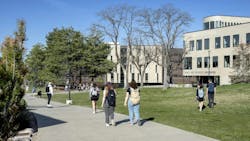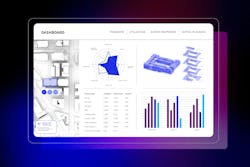How AI can power a culture of continuous campus planning
This blog post was authored by Kushan Dave, Client Leader, Education Practice, CannonDesign; and Frances Fox, AIA, Principal and Client Leader, Education Practice, CannonDesign.
Higher education institutions can no longer afford to treat master planning as a once-a-decade exercise. Enrollment swings, evolving pedagogies, aging infrastructure and shifting student expectations demand a more nimble, responsive and data-informed approach—one that emerging AI technologies are uniquely positioned to support.
The common practice of launching a comprehensive facility master plan every 10 years has led many higher education leaders to adopt a reactive mindset. It’s an approach that often lacks the necessary flexibility and adaptability to respond to the rapidly changing needs of the campus community and the ever-evolving landscape of higher education.
Moreover, the process itself is resource-intensive and requires 12 to 18 months of sustained engagement, analysis and coordination by the institution. By the time the plan is published, its relevance may already be fading. In many cases, three to five years into the 10-year plan, the framework no longer accurately reflects campus needs.
Why does the planning process take so long, anyway?
There are two key tasks at the start of any master plan process—engagement and data readiness. This balance of qualitative and quantitative data is the foundation for decision making and creation of sound recommendations tied to an institution’s strategic plan.
Engagement is invaluable because it incorporates the lived experience, perspectives, needs and hopes of a broad pool of stakeholders. The process includes institutional and facilities leaders, faculty, students, alumni, prospective students, parents, community members and local industry representatives. This firsthand knowledge and rich experiences of diverse stakeholders are essential to consensus building, but gathering this input is time-consuming and often manual.
At the same time, data related to space inventory, space utilization and deferred maintenance can quickly become outdated. These data sources often live in silos, lack integration and do not have dedicated staff to maintain them annually. As a result, institutional leaders often spend the early phases of a master planning effort simply trying to “catch up.”
But what if institutions didn’t have to start from scratch each time?
By establishing a culture of continuous planning, campuses can avoid this reset by maintaining up-to-date systems and creating regular feedback loops with users about evolving space needs. The growing capabilities of AI are making this shift not only possible but practical and cost effective. With the right tools in place, colleges and universities can stay agile, informed and proactive in the face of ongoing change.
So, how can AI support a culture of proactive, continuous master planning, while retaining the value of human interaction in building consensus on campus? We think it could happen at various scales.
AI automation for continuous and real-time campus data
Accurate data is essential for long-term planning. To collect that data, master planners must invest considerable time in walking campus spaces, speaking to several people, recording their input and analyzing it along with other information. While this data—primarily gathered through individual conversations—is invaluable, the process is taxing and time-consuming. And the data can quickly become outdated due to the rapid changes on campus.
AI has the potential to transform this process using digital twins—virtual models of campus environments that continuously sync with real-world data. Imagine a planning environment where space utilization, maintenance needs, energy use, and scheduling data are automatically updated in real time. This connected system reduces reliance on anecdotal reporting and time-intensive data collection, offering planners and facilities teams immediate access to reliable, actionable insights.
AI as a planning orchestrator
In traditional master planning, the project manager is a central figure responsible for keeping everything on track—from stakeholder coordination and data gathering to timelines, budgets and communications. But in a continuous planning environment, where updates and recalibration happen more frequently, even the most organized team can struggle to maintain momentum.
This is where AI can serve as a valuable orchestrator.
Rather than replacing the human project manager, AI can assist by automating routine coordination tasks: sending reminders for data updates, flagging misalignments between goals and available data, tracking stakeholder inputs over time and surfacing action items as priorities shift. These tools can help maintain rhythm and alignment in an interactive or annual “mini-planning” cycles.
AI facility planning dashboard for institutions
Many institutional facility leaders are feeling the pressure of managing aging structures, limited budgets and hundreds of facility repair and maintenance requests on a regular basis. Additionally, shrinking staff numbers across higher education are forcing design, construction and facility management staff to continue operating their departments with extremely lean teams. Receiving, prioritizing and resolving facility requests often happens in an inefficient and clunky way.
Our team is currently developing a dashboard to receive, sort, analyze requests and recommend actions based on set parameters. It streamlines workflows by automating decision-making for facility repair and maintenance requests, eliminating the need to reference multiple data sources. This dashboard will be designed to support recordkeeping and clean data maintenance over time, enabling campus leaders and their design teams to get updated facility maintenance data at any time.
Paradigm shift? Yes. But it’s worth it.
Imagine a future where campus master planning is no longer a massive, once-a-decade undertaking but rather a seamless and iterative process. Instead of resetting every ten years, institutions could engage in annual or biannual tune-ups to refresh priorities, align with real-time data and refine capital strategies. This “lighter touch” is made possible by providing AI tools needed to continuously update data sets and streamline stakeholder input.
The first step is for institutional leaders to embrace the power of AI to eliminate the traditional methods of data management. By doing so, they position their campuses to respond swiftly to change, strengthen the health and connectivity of their physical spaces and build environments that can truly support the evolving needs of students, faculty and communities for generations to come.
With AI as a planning partner, higher education doesn’t just plan for the future—it builds it in real time.
About the Author
CannonDesign
CannonDesign’s Insights is a place for the global design firm to share thoughts and news related to their current efforts to help transform businesses, educational models and health paradigms. The firm engages diverse perspectives and expertise to deliver proven, innovative solutions to our most important partners, our clients. Our global network of more than a thousand professionals enable us to create design solutions to the greatest challenges facing our clients and society. Follow us on Facebook, Instagram, LinkedIn, and Twitter.




